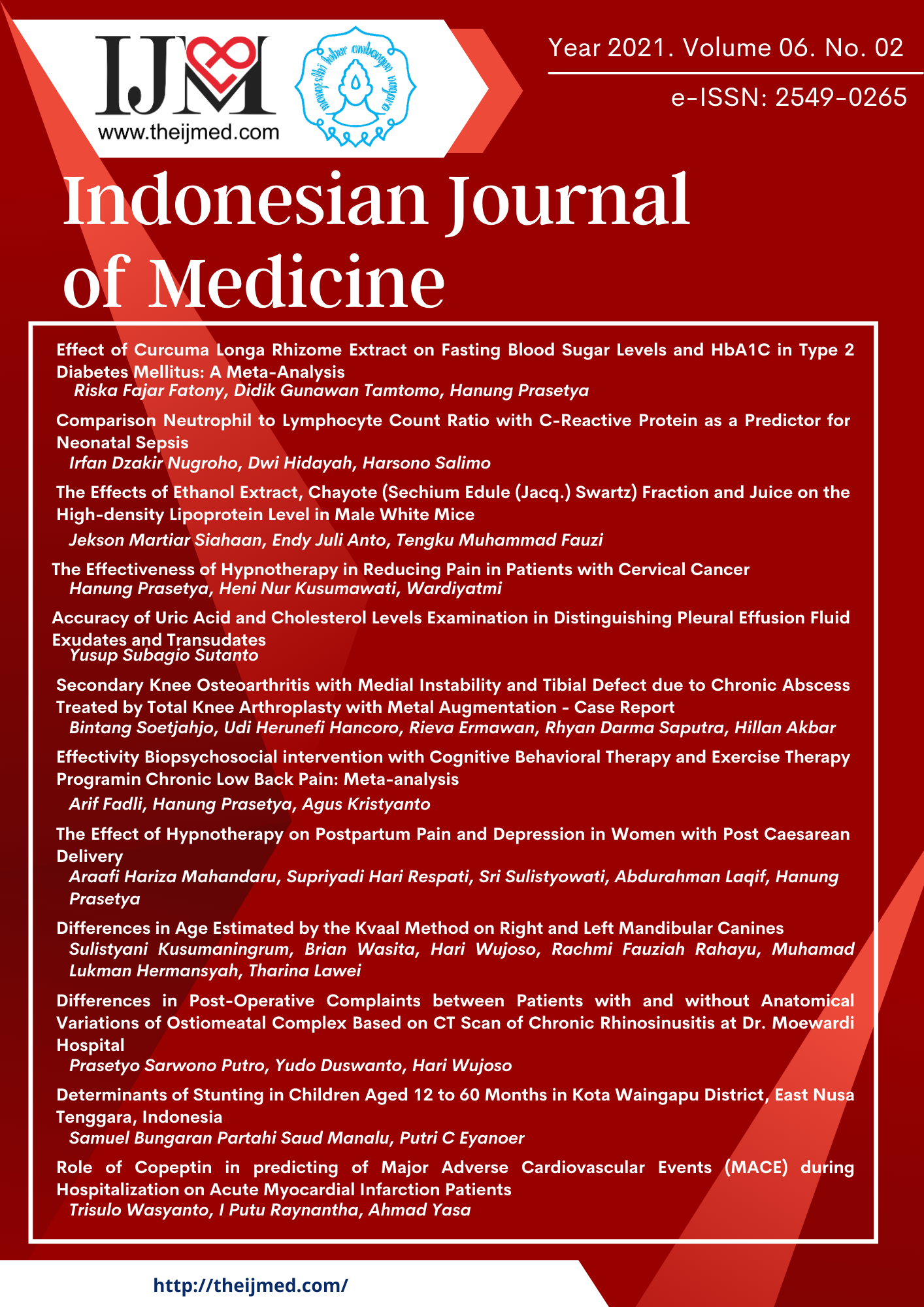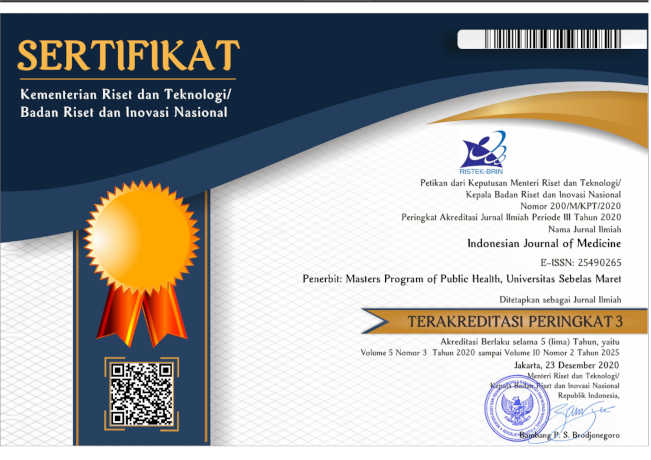Role of Copeptin in predicting of Major Adverse Cardiovascular Events (MACE) during Hospitalization on Acute Myocardial Infarction Patients
DOI:
https://doi.org/10.26911/theijmed.2021.6.2.405Abstract
Background: Copeptin has been considered as a potential biomarker for AMI which also give information regarding the prognostic of the Acute myocardial infarction (AMI). The aim of this study is to understand the role of copeptin as a predictor of major adverse cardiovascular events (MACE) during hospitalization in AMI patients.
Subjects and Method: This was a cohort analytical study conducted at Dr. Moewardi Hospital, Surakarta, from March to May 2021. The dependent variable was MACE. The independent variable was the copeptin level. We observe the MACE during hospitalization and analyze the cut-off point value for optimal copeptin levels to predict the occurrence of MACE using the receiver operating characteristic (ROC) curve. Linear multiple regression was conducted to predict determinants of MACE in hospitalization patients.
Results: 52 patients recruited in this research (44 males, 8 females). During hospitalization, MACE occurred in 52% of these subjects, with the respective proportions for acute heart failure, cardiogenic shock, arrhythmias, cardiopulmonary resuscitation, and mortality of 28%, 10%, 8%, 4%, and 2%. The ROC curve showed that the cut-off point of copeptin was 2,141.50 pg/mL and area under curve (AUC) value of 0.710 with sensitivity of 75.0%, specificity of 68.80% and accuracy of 71.15%. Hence, the AUC values and accuracy present fair results for predicting MACE during hospitalization in AMI patients.
Conclusion: Copeptin has a role as a predicttor of MACE during hospitalization in AMI patients.
Keywords: copeptin, mayor adverse cardiovascular events, acute myocardial infarction
Correspondence: Trisulo Wasyanto. Department of Cardiology and Vascular Medicine, Faculty of Medicine, Universitas Sebelas Maret/ Dr. Moewardi Hospital. Jl. Kol. Sutarto 132, Surakarta 57126, Central Java. Email: trisulo.wasyanto@gmail.com.
Indonesian Journal of Medicine (2021), 06(02): 230-238
https://doi.org/10.26911/theijmed.2021.06.02.12.
References
Braunwald E, Bonow RO, Mann DL, et al. (2019). Approaching to the patient with chest pain. In: Bonaca MS and Saba¬tine MS. Braunwald’s Heart Diseases Textbook of Cardiovascular Medicine (11th Ed.). Philadelphia: Elsevier Saunders.
Choi HJ, Kim MC, Sim DS, Hong YJ, Kim JH, Jeong MH, Kim SH, et al. (2018). Serum copeptin levels predict clinical outcomes after successful percutane-ous coronary intervention in patients with acute myocardial infarction. Ann Lab Med. 38(6): 538-544. https://doi.org/10.3343/alm.2018.38.6.53.
Dieplinger B, Gegenhuber A, Kaar G, Poelz W, Haltmayer M, Mueller T (2010). Prognostic value of established and novel biomarkers in patients with shortness of breath attending an emergency department. Clin Bio-chem. 43(9): 714–719. https://doi.org/10.1016/j.clinbiochem.2010.02.002.
Enhörning S, Wang TJ, Nilsson PM, Alm-gren P, Hedblad B, Berglund G, Struck J, et al. (2010). Plasma copep-tin and the risk of diabetes mellitus. Circulation, 121(19): 2102–2108. https://dx.doi.org/10.1161%2FCIRCULATIONAHA.109.909663.
Katan M, Christ-Crain M (2010). The stress hormone copeptin: a new prognostic biomarker in acute illness. Swiss Med Wkly. 140(w13101): 1-6. https://doi.-org/10.4414/smw.2010.13101.
Lattuca B, Sy V, Nguyen L, Bernard M, Zeitouni M, Overtchouk P, Yan Y, et al. (2019). Copeptin as a prognostic biomarker in acute myocardial infarction. Int J Cardiol, 274: 337-341. https://doi.org/10.1016/j.ijcard.2018.09.022.
Lippi G, Plebani M, Somma SD, Monzani V, Tubaro M, Volpe M, Moscatelli P, et al. (2012). Considerations for early acute myocardial infarction rule-out for emergency department chest pain patients: the case of copeptin. Clin Chem Lab Med. 50(2): 243–253. https://doi.org/10.1515/cclm-2011-0845.
Nickel CH, Bingisser R, Morgenthaler NG (2012). The role of copeptin as a diag-nostic and prognostic biomarker for risk stratification in the emergency department. BMC Med. 10(7): 7-10. https://doi.org/10.1186/1741-7015-10-7.
Parizadeh SM, Ghandehari M, Parizadeh MR, Ferns GA, Ghayour-Mobarhan M, Avan A, Hassanian SM (2018). The diagnostic and prognostic value of copeptin incardiovascular disease, current status, and prospective. J Cell Biochem. 119(10): 7913-7923. https://doi.org/10.1002/jcb.27093.
Reichlin T, Hochholzer W, Stelzig C, Laule K, Freidank H, Morgenthaler NG, Bergmann A, et al. (2009). Incre-mental value of copeptin for rapid rule out of acute myocardial infarc-tion. J Am Coll Cardiol, 54(1): 60–68. https://doi.org/10.1016/j.jacc.2009.01.076.
Roth GA, Johnson C, Abajobir A, Abd-Allah F, Abera SF, Abyu G, Ahmed M, et al. (2017). Global, regional, and national burden of cardiovascular diseases for 10 causes, 1990 to 2015. J Am Coll Cardiol, 70(1): 1-25. https://doi.org/10.1016/j.jacc.2017.04.052.
Von Haehling S, Papassotiriou J, Morgen-thaler NG, Hartmann O, Doehner W, Stellos K, Wurster T, et al. (2012). Copeptin as a prognostic factor for major adverse cardiovascular events in patients with coronary artery disease. Int J Cardiol. 162(1): 27-32. https://doi.org/10.1016/j.ijcard.2011.12.105.
Thygesen K (2018). What's new in the Fourth Universal Definition of Myo-cardial infarction. Eur Heart J. 39 (42): 3757-3758. https://doi.org/10.-1093/eurheartj/ehy655.
Urwyler SA, Schuetz P, Fluri F, Morgentha-ler NG, Zweifel C, Bergmann A, Bing-isser R, et al. (2010). Prognostic value of copeptin: one-year outcome in pati-ents with acute stroke. Stroke. 41(7): 1564–1567. https://doi.org/10.1161/strokeaha.110.584649.
Virani SS, Alonso A, Aparicio HJ, Benjamin EJ, Bittencourt MS, Callaway CW, Carson AP, et al. (2021). Heart disease and stroke statistics-2021 update. Circulation. 143(1): e626-e628. https://doi.org/10.1161/cir.00-00000000000950.
Wasyanto T, Tridamayanti A (2019). Blood urea nitrogen as a predictor of in-hospital mortality in acute coronary syndrome patients. Indones J Med. 4(3): 241-251. https://doi.org/10.269-11/theijmed.2019.04.03.07.











